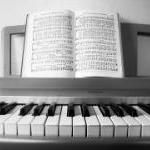Search the Community
Showing results for tags 'piano'.
-
so umm... music is one of my ways of procrastinating, believe it or not This sonata is written with my friends and my own struggles in mind. I won't go through the details of the piece as I believe analysis should be objective, but I would offer some of my experience and comments about this piece. fingerings and metronome marks are for guidance only, even I myself am not able to don't follow everything on the score. my recording of this movement takes 10 minutes but it's only 6+ minutes played by the computer, so seems like I took quite some time irl in playing the piece I find it very hard to interpret this movement, there is a lot of silence and "nakedness" if you get what I'm saying... but I don't do music for a living, so I'm not going to suffer from practice-till-perfect "ad lib" - add your own cadanza bars 161-163 - feel free to turn the bass into an octave if you play the Bosendorder imperial lol it seems like a problem for me is that my first movements are full of dissociated ideas (just like me as a person...) The introduction part of the movement had been set in stone for a while, but the exposition and recap of the movement was rewritten for a 3rd time, I basically discarded the first two ideas... but managed to fit the entire development section from how I wrote it the first time, so in fact you could even say I wrote the development of the sonata before the exposition, and it really shows. feel free to comment or critique, hopefully I'm receptive (you could tell I'm a rather stubborn person...) EDIT: I found out the spoiler function, so I will provide some more aspects regarding the creation of this sonata. Be warned though, spoilers ahead, even when this is just a discussion of the first movement, it will touch on aspects in later movements, not just the first one. If you prefer to listen to the whole thing before reading, you might want to do so after I have posted all the movements. 1. overall structure of the movement. I won't state bar numbers because I think the double barlines do a great job already 2. harmonic motifs Tell me more if I have missed other things in my own music (that is if you are prepared to be spoiled for this movement and the next ones..) Link to second movement:
-
Hi everyone! I am presenting the fourth movement of my Piano Sonata no.2 in A-flat major. The previous 3 movements are now all sorted in the post of the 1st movement one so if you are interested, go and check them out! This is my favourite movement of the entire sonata. First it's in C sharp minor, my favourite key. Second it really has something personal in it. The structure of it is very simple: 00:03 First Part, melody in right hand and octave accompaniment in LH 04:13 Second Part. original melody to the right with added Lamentoso in RH 07:34 Coda. Is that a dark reply to the first movement? The movement is named a "Lyrics" for me. Chinese poems are known to be lyrics, rather than long epics like those of Homer or Milton or Goethe. I'm trying to adapt the rhythm of Tang Poem, Lüshi here which contains five or seven words in each sentence with standard rhythm to recite it. It also contains many couplets. With reference to it I have a standard rhythm maintaining all over the movement and is having many couplets musically. In the first part the LH keeps having the octave accompaniment which can be boring but for me it helps create an unsettling feeling. In the second part, the original melody in the RH of the first part is transferred to the LH, while a lamentoso is added in the right hand. The coda returns to the first part version of the meldoy, but look at the ending. Is that a dark deeply or quotation to the con delore section of the first movement, b.82-98? The tragedy uncertain there is confirmed here. I myself feel like this movement is quite unrelated thematically to the rest of the sonata. But it's related in a different way. It represents the real hurdle in the subconscious finally emerges in front of you. The unsettling C# minor (Db minor) is hinted all over the first three movements: The con delore section (b.82-98) in first movement, that surprising Db minor cadence near the end of the second movement (which by the way is the answer of why there's agitation there), and the coda of the third movement tainted by Db minor. All prepares for this movement. I find this piece somewhat similar to the second movement of Schubert's D960, which is also in C sharp minor, but only after finishing this sonata. The movement for me is very dark hence very personal. I'm sure I have something dark personally and here it's expressed authentically. I literally get depressed every time after listening to this movement. How do you feel? Do you feel this movement boring or so with so slow a tempo and unchanging things? Let me know! As usual I'm going to attach the PDF and mp3 of the movement: Piano Sonata no.2 4th mov 26-04-2023.pdf Piano Sonata no.2 4th mov.mp3 (Please ignore the first three lines of p.1 as it's from 3rd movement!) And as usual I will attach the youtube video here of the scored version of the movement. There's some delay of the visual here though LoL... Please subscribe my channel! (Self advertising LoL!!!!!!!!!) Hope you all "enjoy" the movement! The fifth movement and the finale of the sonata will be a long way to go, as I don't start practicing it due to busy schedule and other accompanying stuff to do. See you soon! Henry
-
Hi guys, this is the first (complete) piece I have composed. It was inspired by the painting "The Raft of the Medusa" by Théodore Géricault, which I found whilst I was surfing the internet for inspiration. I'm hoping to use it as part of a larger work later on, but here it is as it stands. The piece is in ternary form (A-B-A), with the A section being in G minor, and the B section being in the Dominant(D Major). The A Section is supposed to invoke the dispair that the sailors on the raft must've felt as they were sailing, and their cries for help. The B section is supposed to be some sort of cheer up song, that the sailors sing (and waltz to), to try and cheer themselves up. Eventually, the despair and pain of their ordeal overwhelms them, and they stop singing, and start crying for help again, hence the repeat of the A section. I do hope you enjoy my piece, and I would appreciate some feedback on it, Yours Faithfully, Expert21 P.S. I apologise in advance for some of the discrepancies in the notation, I hope to fix it when I have more time.
- 5 replies
-
- 1
-

-
- violin and piano duo
- duet
-
(and 2 more)
Tagged with:
-
I've just finished a new piece today! Here's a waltz that I had written for a competition (I didn't submit in the end, the entry fee was too costly), in Ab major. At first I had planned for it to have been for solo piano (inspired very much by Chopin's waltzes), but eventually I added a solo violin part for (at least some) more timbral variety. Would appreciate some good criticism: this the first waltz I've written, and also the first in my (obviously limited) oeuvre to 'explore' the circle of fifths. Hope you enjoy, and let me know what you think! 🙂
-
Yet another improv, i worry im boring people with these! I'll stop doing it soon, I.promise! I've started writing down my compositions/improvs again. I have a couple of minuets I'll upload soon, I just get so distracted when I sit at the piano. I've composed, via improv, a piano sonata in C major, I was thinking of the third movement when I improvised this. It reminds me of Haydn, I want the third movement to be light hearted and playful because the second movement I composed is in c minor and I use every trick up my sleeve to pull on the heart strings. I wish I recorded myself playing it, I worry my memory of it could get corrupted because it has more complex counterpoint. The first movement is like a piano concerto and is full of flashy runs in both hands. It has a Mozartian air and I use some of his signature moves but it has enough of me in it so it's not a cringey pastiche. Well I hope not! The improv here is a 'first run' so it's full of hesitation and mistakes but it made me smile when I listened back to it so I thought I'd upload it, I've been quiet for a few days so why not. Cuckoo!
- 10 replies
-
- 5
-

-
- galant
- improvisation
-
(and 1 more)
Tagged with:
-
Brand new release! 11 Variations on an original theme for solo piano. Starts Classical, becomes Romantic, and ends in 7/8! Hope to lift your spirits. https://www.youtube.com/watch?v=-3coQsksLiE Thanks!
-
Hello everybody! This is my new piece as a result of my orchestral piece break. I said in my latest post that I was going to upload a prelude, that is still coming, but I kinda wanna try composing a vocal work, so here it is! Searching the material for this work was tough, but I stumbled upon an impromptu poem performed by a character (Scrump Toggins) while watching a roleplay session on WildRP. If I get enough material, maybe I will make a full song cycle, but who knows. Also, there's a quote from a piece that I've uploaded here somewhere in the piece, have fun finding that lol Anyways, this is my first time ever trying to compose a vocal work, so all feedbacks and opinions are appreciated. Enjoy! (P.S Y'know, if anybody wants to sing this I'll gladly provide the instrumental version 👀)
-
Hello Guys, Here's my new piece of music, Spring Night. I'm really interested in your opinion!
-
Here it is, as short as possible to say something.
- 3 replies
-
- 2
-

-
- piano
- piano ballad
-
(and 1 more)
Tagged with:
-
Another bagatelle I compose all day everyday, I am starting to rack up the scores! Enjoy!
-
Last piece of my 1st opus. Constructive criticism is warmly welcome!
-
Let me introduce my Ballad No. 3 (E flat major) for solo piano. When I wrote this music, I wanted to make the composition as melodically expressive as possible. I also tried to make as clean chords as possible without harsh dissonances. I hope this Ballad will not look too old-fashioned. I just wrote the music I wanted to listen to. If someone liked it, I will be very happy.
-
Hi everyone! I am here to present the third movement of my Piano Sonata no.2 in A-flat major. Previous two movements are also posted in YC and you can have a look in them if you're interested: The third movement opens with the opening theme of the first movement in a more flowing manner with some counterpoint. It also plays with the texture of the second movement with the movement almost non-stop with the quavers except some cadential moments. The pdf and mp3 files are attached as usual: Piano Sonata no.2 3rd Movement.mp3 Piano Sonata no.2 3rd mov 26-04-2023.pdf The movement is in sonata form without a development, since nothing needs to be developed here as an Intermezzo: 00:00 Exposition, 1st Subject 00:31 Transition (?) 01:15 Exposition, 2nd Subject 02:01 Recapitulation, 1st Subject 02:26 Transition (?) 02:53 Recapitulation, 2nd Subject 03:40 Coda, roads leading to the main hurdle... (Even I myself am not sure where is the beginning of the transitions and 2nd subjects since there's no medial caesura...) For me this is my least favourite movement of the sonata. I feel like it's less emotional and authentic here than any other movements. But of course this can be a bias. The youtube video is also attached here: After this movement it's time for the real hurdle and my favourite movement of the sonata... Even though it's prepared and hinted throughout the previous movements but the coda of this movement cannot tell less of it... Stay tuned... Henry
-
For the past 18 months I've not been active much musically. I'm back now and bursting with ideas. This piece began as a minuet but ended up an improvised fantasy. I composed the minuet ages ago and recently had access to my piano so I hit record and played it. I was playing from memory and had dumb fingers where Ive been away from the piano for so long and I forgot how to play. So it begins hesitantly and annoyingly I forgot how to play the coda of the minuet so began improvising from that point onward. I transitioned to the trio but it sounded nothing like a trio as I improvised but I liked the ideas I was coming up with and carried on. By the time the minuet returns at the end I found my confidence again. Cant believe I earned the 12 year badge, has it really been that long?! Are there many others still here who joined back then?
- 3 replies
-
- 2
-

-
- improvisation
- fantasy
-
(and 1 more)
Tagged with:
-
Here's a short waltz that I'd like to share with everyone. The original score was created last 2014 as a soundtrack for a video project in college. It was originally for a couple string instruments. In 2019, I transcribed it for solo piano. In the process of transcribing, I accidentally swapped the treble clef of the right hand with the bass clef without changing the note order, thus changing the entire tone of the main melody. It sounded off at first but then I thought, it's not bad at all! So I took that "accident" and incorporated it into the final version of this piece (you'll notice that measures 41 to 56 is like a copy of the main melody but different). Then a few days ago, I finally decided to complete this version. I had fun revising this one, and I hope you enjoy it as well 😁 Waltz in C Major.mp3 Waltz in C major.pdf
-
I present the first five Symphonic Sonatas - beginning in reverse chronologic order. Symphonic Sonata No. 5 in Bb
-
Short original piano composition called "Please!". It is my first composition after a break of 2 years. It is inspired by the music of composers of the romantic era. Another big inspiration was the painting "Lamia" by John Waterhouse. It has the following structure: A - B - C - A' A : Main theme in C Major B : Secondary theme in d sharp minor C : Transition from B to A' in c minor A' : Dramatic variation of A in C Major Thank you for listening! Feel free to comment 🙂
- 8 replies
-
- 4
-

-
- short piece
- romantic
-
(and 1 more)
Tagged with:
-
Dear all, This is a piece I wrote back then, in 2021, for a call-for-score competition of a piano performing competition. This is meant to be a part of the repretoire performers can choose from for their programme. Unfortunately, the competition is heavily impacted by the pendemic and I cannot listen to the live/ streamed performance of this peice. Here is my original note for this work. "This toccata is the second work in the composer’s recent piano series which explore polyrhythmic motif development. The piece starts with a simple, tranquil theme and it evolves into a fast quasi-fugue. Later, the passionate 3-against-5 passage enters with contrasts to the first motif. After the appearance of both motives, variations follow and direct the development for the rest of the toccata. " HoYin
-
Hey everyone, this is a project I did for my Theory: Intro to Harmony class. We started with just a chord progression, then added texture and a melody. I'd love to hear any feedback, and if anyone thinks of a title, please let me know
- 12 replies
-
- 1
-

-
- jazz arranging
- clarinet
-
(and 2 more)
Tagged with:
-
Uno de estos días... One of these days. A simple piano piece, with its twists .... That's the one of my dogs (calle Happy) is.
-
Hi everyone! I have previously posted the second movement of my second Piano Sonata here: Now I am posting the first movement of the work! Here are the pdf and the mp3: Piano Sonata no.2 in A-flat Major First Movement.pdf Piano Sonata no.2 First Movement.mp3 I've also included the YT video here: I didn't introduce the inspiration of this sonata in my post in the second movement to have it here. Piano Sonata no.2 in A-flat major (2015) is composed right after the completion of the first Piano Sonata. It's the quickest composition at all since I had only used 3 weeks to finish the first draft of it.(It's very quick in my standard since well, I can use 6 years to compose my clarinet quintet...) I adopt a freer approach here to contrast with the first Piano Sonata which is very cohesive. Here I really just write what I want and this may result in less tight structure of the overall work. But it's definitely more akin to my emotion and feeling here! I only use 2 days to finish the first draft of this movement in 6-7 May 2015. It begins in a Schubertian manner and several episodes in it, stimulating the later movements and transformed into a Beethovanian one, akin to his op.110 in the same key. I really love how serene this movement begins and motivational at the end! The overall form of the piece can be considered as follow: B.1-32 (00:00-01:18): Main theme, serene and Schubertian in A flat major. Backbone of the piece B.33-81 (01:19-03:16): Secondary theme begins in f minor but confirms the A flat major. Inspire 2nd movement. B.82-98 (03:17-04:00): Doloroso in C sharp minor my favourite key! End of the first part. Inspire 4th movement. B.99-135 (04:01-05:00): Struggling to create power in a Beethovanian manner. B.136-159 (05:01-05:42) Reprise of the opening theme but in Beethovaian manner especially with influence of his op.110 in the same key!!(My favourite Beethovan Sonata too!) B.160-183 (05:43-06:25): Crystallization of the opening theme? Inspire fifth movement esp. its coda. B.184-194 (06:26-06:57): Affirmation of the opening theme though weakened at the end to pave the way to the denial in the second movement. I am very happy to have composed this sonata as I feel like I am free flowing during the process. I also love how the emotions flow within it whether it's serene, hopeful, tragic, agitated or transfigured. I just ignore all those parallel 5ths and 8ves since the sound is great. It may suffer from the lack of coherence though especially in the first movement, but it helps inspire the later movements with the episodes so I am very grateful I make this! The recoding is made in 18/03/2023. There are two obvious slips in 04:06 and 04:12. But the rest of the recording is quite beautiful and faithful to the music so I retain it. Hope you enjoy this as well and thanks for listening!!! P.S The post for the third movement is attached here: The post for the fourth movement is attached here: Henry
-
Since Covid made singing in groups so unsafe, choirs have taken a real hit to their membership, and many are still smaller than they were before the pandemic. I wrote this piece to be performable by a small group. The range of the baritone part should be manageable by either tenors or basses, since they are generally the smallest sections in a choir, to help with balance issues. The baritone part does divide a bit for the sake of interest and to give any bass 2s a break from their high range, but as the piano and other parts are generally covering those splits, they can be done away with if a group only has a single male voice, or a conductor chooses to put all their tenors and basses on a single line to improve balance against larger soprano and alto sections. The ranges of the soprano and alto parts are also moderate enough that an alto 1 could sing soprano or a soprano 2 could sing alto in the case of unbalanced sections. I've mainly limited dynamics to mp and mf, since smaller groups are more likely to have blending and balance issues at very loud dynamics or sound timid at softer ones. I'd love to know your thoughts, particularly pianists! (I'm not a pianist). Does anything seem particularly awkward, or should be written for the other hand? Would the thorny accidentals at measure 63-64 be easier to sight-read at speed if I used the Cb and Bbb enharmonic equivalents, so those righthand notes were in paired thirds going up and down the scale? Thank you for your thoughts! Revelation 21 KJV 1 And I saw a new heaven and a new earth: for the first heaven and the first earth were passed away; and there was no more sea. 4 And God shall wipe away all tears from their eyes; and there shall be no more death, neither sorrow, nor crying, neither shall there be any more pain: for the former things are passed away. 5 And he that sat upon the throne said, Behold, I make all things new. And he said unto me, Write: for these words are true and faithful.
- 5 replies
-
- 1
-

-
- revelation 21:1-5
- environmental destruction
-
(and 7 more)
Tagged with:













